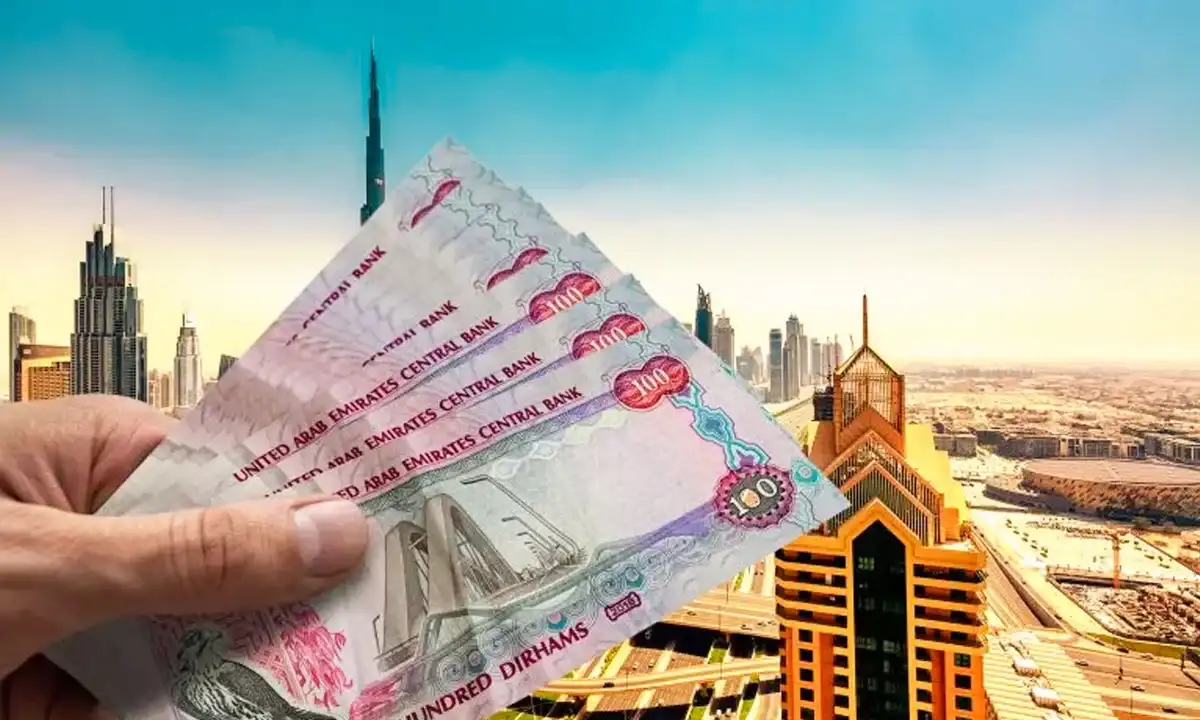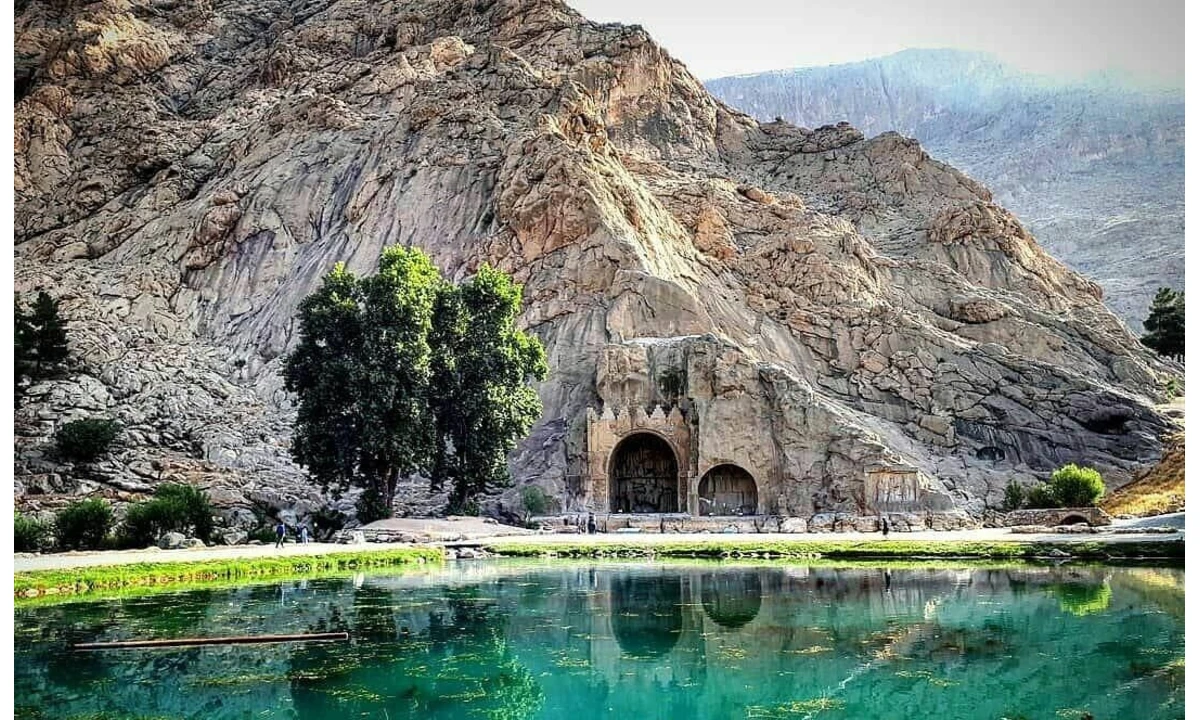Persian Carpet | Everything You Need to Know About Iranian Carpet
![]() Author : Alirezaa | Date : Tuesday 19 November 2024 13:29
Author : Alirezaa | Date : Tuesday 19 November 2024 13:29

When you step into the intricate world of Persian carpets, you embark on a journey that weaves through the rich tapestry of history, culture, and artistry that has been spun for centuries. Persian carpets, known for their unparalleled beauty and craftsmanship, are not merely floor coverings but a testament to the enduring legacy of Persian culture. They encapsulate the artistic expression and the sophisticated skills of weavers who have passed down their knowledge through generations.
Introduction of Persian Carpet
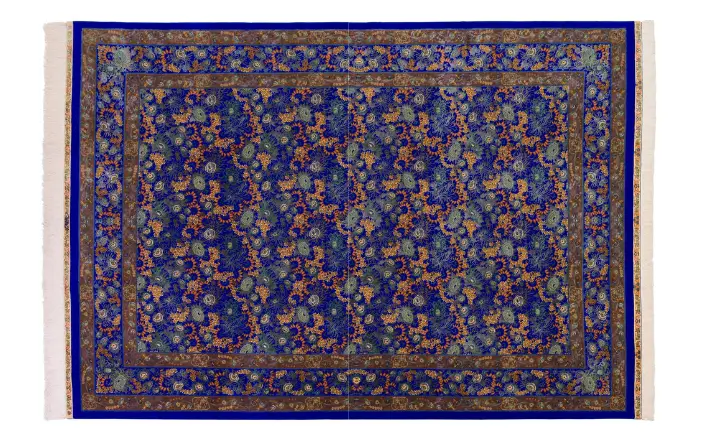
The allure of Persian carpets extends beyond the borders of Iran, reaching into homes and hearts worldwide. These carpets are prized for their intricate designs, vibrant colors, and the stories they tell, making them a focal point in interior design. In the global art scene, Persian carpets are celebrated as masterpieces of textile art, often fetching high prices at international auctions and being sought after by collectors and enthusiasts alike.
For tourists, the experience of exploring Persian bazaars and carpet shops offers a unique insight into this fascinating aspect of Persian heritage. The variety of carpets on display, from the plush, silk rugs of Qom to the robust, woolen weaves of Tabriz, showcases the diversity and richness of Persian craftsmanship. Each carpet tells a story, not only in its pattern and design but in the knots that bind it, offering a tangible connection to the past and a piece of cultural heritage you can take home.
The significance of Persian carpets goes beyond their aesthetic appeal; they are a symbol of the cultural identity and artistic prowess of the Persian people. As you stand before these magnificent works of art, you are not just viewing a carpet but stepping into a world where every weave and color holds a meaning, where the art of carpet making is a language of its own.
Whether displayed in a museum, used as the centerpiece of a living room, or cherished as a valuable collectible, Persian carpets continue to captivate and inspire. They bridge the gap between tradition and modernity, making them an essential element of global art and interior design. For tourists, the journey into the world of Persian carpets is not just about acquiring a beautiful object but about experiencing a rich cultural tradition that has been meticulously crafted, one knot at a time, into a masterpiece that stands the test of time.
History of Persian Carpets
The history of Persian carpets is as rich and colorful as the designs themselves, tracing back to the ancient civilizations that flourished in the region now known as Iran. The origins of these carpets are shrouded in antiquity, with the earliest evidence pointing to the Achaemenid Empire (circa 550–330 BCE), where luxurious textiles were symbols of power and prestige. The famous Pazyryk carpet, discovered in a Siberian burial mound and dated to the 5th century BCE, is the oldest known Persian carpet, offering a glimpse into the intricate art of carpet weaving that has been perfected over millennia.
As the Persian Empire expanded, so too did the art of carpet weaving, evolving through the Sassanian period (224–651 CE) and flourishing remarkably during the Islamic era. The introduction of Islamic art and culture infused Persian carpets with new motifs, patterns, and techniques, reflecting the merging of artistic traditions. The Seljuk Turks' conquest of Persia in the 11th century introduced the Turkish knot, further diversifying the craft.
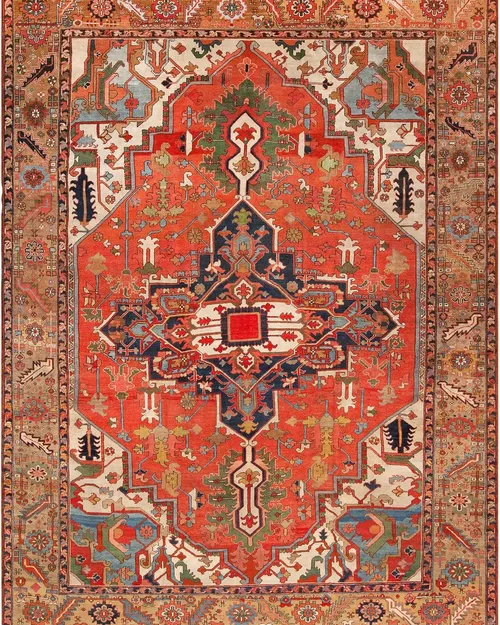
The Safavid dynasty (1501–1736) marks a golden age in Persian carpet making. The Safavids elevated carpet weaving from a craft to an art form, establishing royal workshops and attracting skilled artisans across the empire. This period saw the creation of some of the most exquisite carpets ever made, many of which were exported to Europe and the Ottoman Empire, serving as diplomatic gifts that symbolized the wealth and sophistication of the Persian court.
During the 19th century, the Persian carpet industry experienced significant changes with the introduction of synthetic dyes and the establishment of commercial workshops to meet Western demand. This period also saw the rise of Tabriz, Kashan, Kerman, and Isfahan as major centers of carpet production, each developing distinct styles and techniques that are celebrated to this day.
The role of Persian carpets in trade cannot be overstated. For centuries, they have been a significant export commodity, facilitating cultural exchanges and influencing art and design globally. In the medieval period, Persian carpets adorned the palaces of Europe and the Middle East, symbolizing wealth and cultural sophistication. In the modern era, they continue to be highly valued in international markets, not only for their beauty and craftsmanship but also for their cultural significance.
The influence of Persian carpets extends beyond trade and diplomacy. They are woven into the fabric of Persian literature, poetry, and religious texts, symbolizing paradise, wealth, and power. The art of carpet weaving reflects the history, philosophy, and artistic sensibilities of the Persian people, making each carpet a repository of cultural heritage.
Throughout history, Persian carpets have been more than mere objects of utility or decoration; they are expressions of artistic endeavor, and cultural pride, and a testament to the skill and creativity of Persian weavers. As they continue to be produced, collected, and admired worldwide, Persian carpets remain an enduring symbol of the rich cultural heritage of Iran, bridging past and present, East and West, through their timeless beauty and intricate craftsmanship.
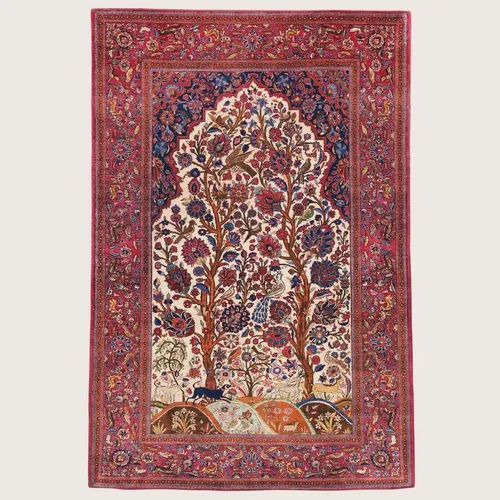
Renowned Weaving Cities of Iran: The Heartlands of Persian Carpet Artistry
The tradition of Persian carpet weaving is spread across various cities in Iran, each known for its unique styles, designs, and weaving techniques. Here are some of the top cities renowned for their Persian carpets, along with the characteristics that distinguish their productions:
Tabriz: Located in Northwest Iran, Tabriz is one of the oldest weaving centers and is known for carpets with intricate designs, high knot density, and a variety of colors and sizes. Tabriz carpets often feature central medallions, floral motifs, and detailed borders.
Isfahan: Isfahan carpets are famous for their high quality, featuring fine wool and sometimes silk on a cotton or silk foundation. The designs are typically elaborate with intricate detailing, including floral motifs, vases, and hunting scenes, rendered in rich colors.
Kashan: Kashan is known for its traditional floral medallion carpets with luxurious wool and silk blends. The city's carpets are highly regarded for their craftsmanship, elegance, and deep, rich colors.
Kerman: Kerman carpets are prized for their high-quality wool, unique designs, and wide palette of colors. They often feature elaborate central medallions surrounded by floral motifs or garden, tree, and animal designs.
Qom: Qom is renowned for its silk carpets, which are among the most luxurious and expensive Persian carpets. These carpets are known for their intricate patterns, fine details, and vibrant colors, often depicting floral and garden scenes.
Nain: Nain carpets are distinguished by their low pile, tight weaving, and the use of ivory and navy blue colors. The designs often involve intricate medallions and floral motifs, with high-quality wool and sometimes silk highlights.
Bidjar: Known as the "iron rugs of Iran," Bidjar carpets are noted for their durability and dense weaving. They feature bold, geometric patterns and a thick, heavy pile, making them highly resilient.
Mashhad: Located in the northeast of Iran, Mashhad carpets are known for their large size, medallion designs with floral motifs, and a predominance of red and blue shades. They are typically made of high-quality wool.
Heriz: Heriz carpets are appreciated for their robustness and rustic charm, featuring geometric designs, large medallions, and distinctive use of bold, earthy colors. The wool used is hard-wearing, making these carpets particularly durable.
Isfahan stands out as a major destination for purchasing Persian carpets, renowned for its exceptional craftsmanship and exquisite designs that capture the essence of Persian artistry. Within this historic city, several shops are notable for their quality selections and reputable service. Among these, the Isfahan Carpet Bazaar offers a labyrinth of choices, showcasing the best of local weaving traditions. Also, Isfahan Rug, located in Abbasi Shopping Center, offers various legit choices. Additionally, Ali Qapu Carpet Gallery and Chehel Sotoun Carpet House stand as prime examples of establishments where connoisseurs and newcomers alike can explore a vast array of carpets, from silk masterpieces to durable woolen weaves, each piece reflecting the rich cultural heritage of Isfahan.
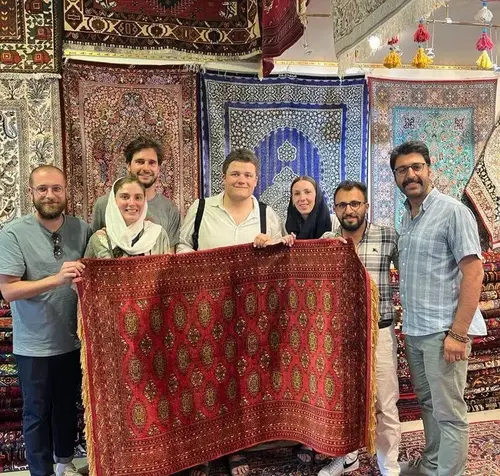
Each of these cities contributes to the rich diversity of Persian carpet artistry, offering a wide range of styles, designs, and qualities that cater to different tastes and preferences. The reputation of these cities for carpet weaving not only underscores the cultural importance of this craft in Iran but also ensures their place in the global market for fine carpets.
✔️Read More : When is the best time to visit Iran?
Persian Carpet Types and Designs
Persian carpets are renowned for their diverse styles, patterns, and the rich symbolism woven into each piece. These elements vary significantly across regions, each with its own distinctive designs, motifs, and materials, reflecting the unique cultural, historical, and environmental influences of the area.
Regional Designs
- Tabriz Carpets: Originating from the city of Tabriz in Northwestern Iran, these carpets are known for their diverse designs, ranging from medallion patterns to detailed pictorial scenes. Tabriz rugs often feature a high knot density, allowing for intricate detailing and a luxurious finish. The quality and complexity of design in Tabriz carpets make them highly sought after.
- Kashan Carpets: Kashan is famed for its traditional floral patterns, medallions, and highly detailed borders. These carpets often have a wool pile on a cotton base, with older examples sometimes featuring pure silk. The colors are typically rich, with deep blues, reds, and ivory forming the backdrop for the elaborate designs.
- Isfahan Carpets: Isfahan rugs are prized for their high-quality craftsmanship, including a high knot count and exquisite, intricate designs featuring elaborate curvilinear patterns, vases, palmettos, and floral motifs. The color palette is usually soft, incorporating pastel shades alongside traditional blues, gold, and greens.
- Qom Carpets: Known for their fine silk threads, Qom carpets are highly decorative, often featuring intricate designs with a clear preference for floral, garden, and medallion themes. The use of silk allows for extremely fine knotting, resulting in carpets of exceptional detail and vibrancy.
Significance of Motifs, Colors, and Symbols
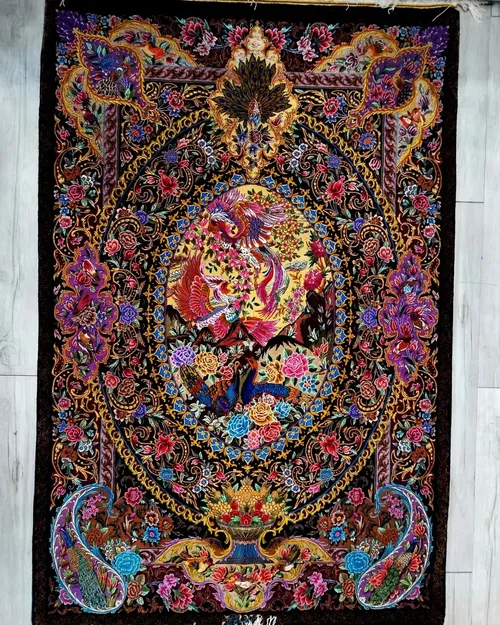
Persian carpets often incorporate a wide range of motifs and symbols, each with its own meaning. Common motifs include:
- Boteh or Paisley: Symbolizing life and eternity.
- Gul: A medallion-like design, often floral, representing the universe.
- Mihrab: Indicative of a prayer niche in a mosque.
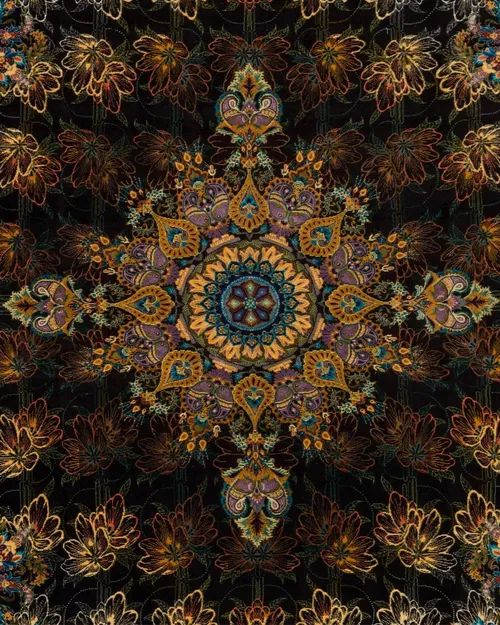
- Garden: Symbolizing paradise, with carpets often divided into quadrants representing a garden's layout.
- Animals and Birds: Depicted in hunting scenes or as symbols of power, wisdom, or faithfulness.
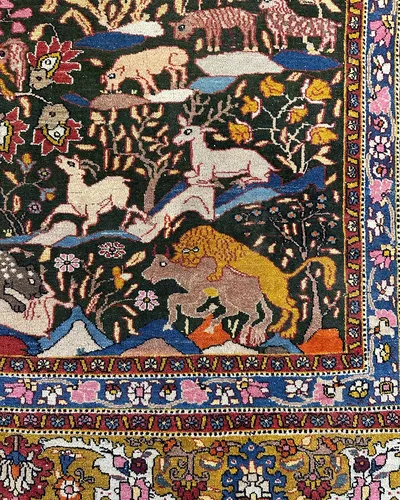
The colors used in Persian carpets also carry significant meaning, with red symbolizing beauty, wealth, courage, luck, and joy; blue representing power, solitude, and truth; and green denoting paradise, spring, and renewal.
✔️Read More : About Monabbat Kari | Iranian Wood Carving Art
Materials and Dyes
- Wool: The most commonly used material in Persian carpets, valued for its durability, elasticity, and natural resistance to dirt. Wool from different regions varies in quality, with some areas known for producing exceptionally fine wool.
- Silk: Used primarily in high-quality, luxury carpets, silk allows for tighter weaving and more intricate designs due to its strength and fine texture. Silk carpets are highly prized for their sheen and delicate appearance.
- Cotton: Often used as the foundation material for both wool and silk carpets due to its strength and durability, providing a stable base for the knots.
Traditionally, Persian carpets were dyed using natural dyes derived from plants, minerals, and insects, which produced a rich, varied color palette that aged beautifully over time. In the late 19th and early 20th centuries, synthetic dyes were introduced, offering a broader range of colors and consistency. However, there has been a resurgence in the use of natural dyes in recent years, as they are valued for their depth, subtlety, and the way they age gracefully.
The diversity in styles, designs, materials, and colors used in Persian carpet making not only showcases the rich tapestry of Persian culture and history but also highlights the artisans' skill and creativity. Each carpet is a unique work of art, telling a story and adding a touch of timeless beauty to any space.
Persian Carpet Price
The price of Persian carpets varies widely based on factors such as craftsmanship, materials, size, age, and origin. Here's a general overview:
Low Range (< $500): Smaller, less intricate designs, possibly machine-made or of simpler hand-knotted patterns.
Mid Range ($500 - $5,000): Hand-knotted carpets with more intricate designs and higher quality materials. The size and complexity of the design can affect the price within this range.
High Range (> $5,000): Includes larger, finely crafted hand-knotted carpets with high knot counts, rare designs, antique carpets, and those made from luxury materials like silk.
Specific examples:
Hand-knotted wool Runner Rug (3'1" x 9'5"): Priced at around $400.
Hand-knotted wool Rug (8'2" x 12'0"): Priced at approximately $1,550.
Antique and High-End Collectible Persian Carpets: Can reach prices as high as $185,000 for palace-sized, rare, or historically significant pieces.
Craftsmanship and Techniques
The creation of a Persian carpet is a meticulous and time-honored process, involving several stages from the initial preparation of materials to the final finishing touches. This craft passed down through generations, showcases the high level of skill and dedication of the artisans.
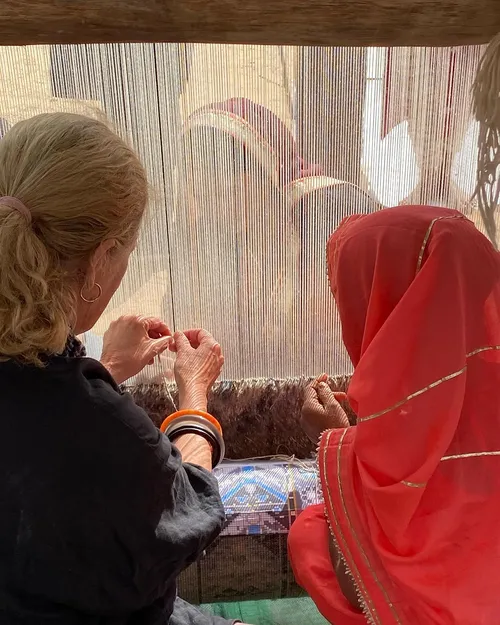
Carpet-Making Process
Spinning the Yarn: The process begins with the spinning of wool, silk, or cotton fibers into yarn. Traditionally, this is done using a spinning wheel or drop spindle, allowing for control over the yarn's thickness.
- Dyeing the Yarn: Once spun, the yarn is dyed. Historically, natural dyes were used, derived from plants, minerals, and insects. Today, both natural and synthetic dyes are used, offering a wide palette of colors. The dyed yarn is then dried, often in the sun, to fix the colors.
- Designing the Pattern: Before weaving begins, the design of the carpet is planned. This can be done through a detailed drawing known as a 'cartoon', which serves as a blueprint for the weavers.
- Preparing the Loom: The loom is set up with a warp (vertical threads) made of cotton, silk, or wool. The quality of the warp contributes to the durability and stability of the carpet.
- Weaving: The heart of carpet making, weaving is done by hand, knot by knot. The two primary types of knots used are the Persian (Senneh) knot and the Turkish (Ghiordes) knot. The choice of knot affects the carpet's texture and appearance. As the weaving progresses, the weaver follows the design, tying knots around the warp threads and cutting the yarn to create the pile.
- Trimming the Pile: Throughout the weaving process, the pile is periodically trimmed to ensure uniformity in height.
- Washing: After weaving, the carpet is washed to remove any dust and excess dye. This process can enhance the vibrancy of the colors and the softness of the pile.
- Stretching and Drying: The washed carpet is stretched on a frame to dry, ensuring it retains its shape and size.
- Finishing Touches: Finally, any additional details, such as fringes or side finishes, are completed, and the carpet is inspected for quality.
Hand-knotted vs. Machine-Made Persian Carpets
The distinction between hand-knotted and machine-made carpets lies in their manufacturing process and the quality of the final product. Hand-knotted carpets are made entirely by hand, with each knot tied individually, resulting in a unique piece that can last for generations. This labor-intensive process contributes to the high value and quality of hand-knotted carpets.
Machine-made carpets, on the other hand, are produced much faster using automated looms. While they can mimic the appearance of hand-knotted rugs, they lack the same level of detail, texture, and durability. Machine-made rugs are generally less expensive but do not possess the same investment value or artisanal charm as their hand-knotted counterparts.
Role of Craftsmanship in Value and Quality
The value and quality of a Persian carpet are directly tied to its craftsmanship. Factors that determine this include the knot density (knots per square inch or centimeter), the complexity of the design, the quality of the materials used, and the skill of the weaver. Higher knot density allows for more detailed designs and a more durable carpet. The use of high-quality, natural materials like wool, silk, and natural dyes also enhances the carpet's aesthetic appeal and longevity.
The craftsmanship of Persian carpets is not merely a matter of technical skill but also an expression of cultural heritage and artistic expression. The dedication to maintaining traditional techniques, while also embracing innovation where appropriate, ensures that each carpet is not just a decorative item but a piece of history and art.
Cultural Significance of Persian Carpet
Persian carpets hold a profound place in the cultural fabric of Iran, embodying the artistic, historical, and social ethos of the Persian people. Their significance extends beyond their utility, permeating literature, art, daily life, and even the spiritual realm of the culture.
Role in Persian Culture
In Persian culture, carpets are more than just floor coverings or decorative items; they are integral to the concept of home and hospitality. They provide warmth, comfort, and beauty to living spaces and are often among the most treasured possessions in a Persian household. The art of carpet weaving is a highly respected craft, with master weavers enjoying a status akin to artists.
Persian carpets are also deeply woven into the literary and artistic traditions of Iran. They are mentioned in the works of classical Persian poets, such as Rumi and Hafez, who often use the carpet as a metaphor for the divine, the universe, or the complexities of existence. In Persian miniatures and paintings, carpets are frequently depicted, underscoring their importance in daily life and ceremonial contexts.
Symbolism and Storytelling
The designs of Persian carpets are rich in symbolism, with each motif, color, and pattern carrying specific meanings. Common motifs such as the tree of life, garden (paradise), animals, and floral patterns are symbolic representations of divine beauty, life, and renewal. The use of these symbols turns each carpet into a narrative, telling stories of nature, mythology, or the weaver's aspirations and worldview.
Carpets are also a medium for storytelling, with some featuring scenes from Persian epic tales, such as the Shahnameh, or depicting important historical events and figures. This storytelling aspect makes each carpet a piece of cultural expression, preserving and conveying the values, beliefs, and stories of the Persian people across generations.
Investment and Ceremonial Uses
Persian carpets are considered valuable investments, with antique pieces and those made with rare materials (such as silk) or techniques fetching high prices in international markets. The craftsmanship, age, design, and materials of the carpet determine its value. Collectors and enthusiasts seek out Persian carpets not only for their beauty but also for their potential to appreciate in value over time.
In addition to their aesthetic and investment appeal, Persian carpets have ceremonial and cultural uses. They are often part of wedding dowries, symbolizing wealth and bringing blessings to the newlyweds. Carpets also play a role in religious practices, serving as individual prayer rugs or covering the floors of mosques, providing a soft, clean place for worship.
The cultural significance of Persian carpets extends beyond their physical beauty, embodying the essence of Persian art, spirituality, and tradition. Through their creation, use, and preservation, Persian carpets continue to be a vibrant thread in the cultural tapestry of Iran, celebrated for their craftsmanship, artistry, and deep symbolic meaning.
Tips for Collecting and Caring for Persian Carpets
Collecting Persian Carpets:
- Research: Understand the different styles, regions, and qualities of Persian carpets. Knowledge about the history, designs, and weaving techniques can enhance your collection's value.
- Condition and Authenticity: Check for the carpet's condition and authenticity. Look for signs of wear, repairs, and the quality of the material and dyes.
- Provenance: Provenance can add value to a carpet. A well-documented history or previous ownership by notable collectors can enhance its appeal.
- Market Trends: Stay informed about market trends and prices. This knowledge can help you make informed purchases and investments.
Caring for Persian Carpets:
- Regular Maintenance: Vacuum lightly without a beater bar to remove dust and grit. Rotate the carpet periodically to ensure even wear.
- Professional Cleaning: Have your carpets professionally cleaned every few years, depending on foot traffic, to preserve their colors and fibers.
- Avoid Direct Sunlight: Protect carpets from prolonged exposure to direct sunlight to prevent fading.
- Spill Management: Address spills immediately by blotting with a clean, dry cloth. Avoid rubbing the spill into the fibers.
Further Study and Info about Iranian Carpet
Exploring the rich world of Persian carpets offers a fascinating journey through history, art, and culture. Below are recommendations for books, documentaries, museums, and online resources that provide deeper insight into this intricate art form.
Books
"Persian Carpets: The Nation as a Transnational Commodity" by Reza Banakar - An insightful analysis of Persian carpets as both cultural symbols and commodities in the global market.
"The Carpet Wars: From Kabul to Baghdad: A Ten-Year Journey Along Ancient Trade Routes" by Christopher Kremmer - A compelling narrative that explores the history and politics of Central Asia through the lens of carpet making and trade.
"Oriental Carpet Design: A Guide to Traditional Motifs, Patterns, and Symbols" by P.R.J. Ford - A comprehensive guide to the designs, motifs, and history of Oriental carpets, including those from Persia.
"The Persian Carpet" by A. Cecil Edwards - Considered one of the most authoritative texts on Persian carpets, covering history, weaving techniques, and regional variations.
Documentaries
"Weaving the Threads of Silk" - This documentary delves into the intricate world of silk Persian carpets, showcasing the craftsmanship and cultural significance behind these luxurious textiles.
"Carpet of Dreams" - A film exploring the art of Persian carpet weaving, focusing on the stories of individual weavers and the challenges they face in the modern world.
Museums
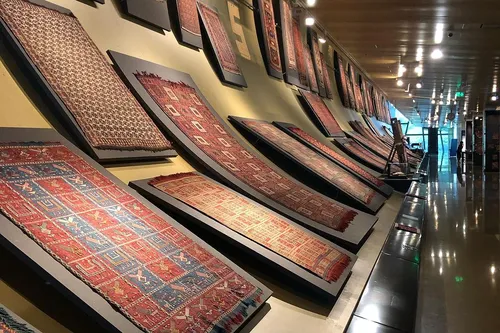
Carpet Museum of Iran, Tehran - Dedicated to Persian carpets, this museum houses one of the richest collections of Persian rugs worldwide, spanning various periods and regions.
The Metropolitan Museum of Art, New York - Offers a collection of Islamic art that includes beautiful Persian carpets, accessible both in person and through their online collection.
Victoria and Albert Museum, London - Home to a significant collection of Islamic art, including Persian carpets, with detailed descriptions and high-resolution images available online.
✔️Read More : Persian Miniature
Last Word
Persian carpets stand as a testament to the enduring legacy and profound significance of Persian culture, artistry, and craftsmanship. These exquisite textiles are more than mere decorative items; they are woven narratives that encapsulate centuries of history, tradition, and cultural identity. With each knot and color, Persian carpets tell stories of the past, embodying the skills and artistic visions of generations of weavers.
The beauty of Persian carpets lies not only in their visual appeal but also in their ability to bridge the past with the present. They serve as a vibrant thread connecting different cultures and traditions across time and space, showcasing the universal appreciation for beauty, craftsmanship, and cultural expression. In homes, museums, and collections worldwide, Persian carpets continue to enchant and inspire, proving that the art of weaving is a timeless language that speaks to the shared human experience.
As symbols of cultural heritage and artistic achievement, Persian carpets remind us of the rich tapestry of human history and the enduring power of art to transcend boundaries. Their legacy is a tribute to the artisans who have kept this ancient tradition alive, ensuring that the story of Persian carpets continues to unfold, linking generations and bridging worlds.

